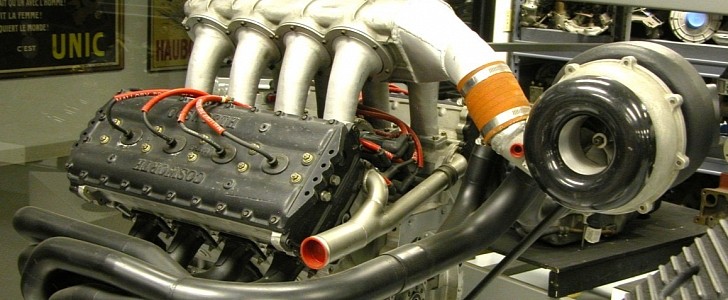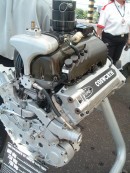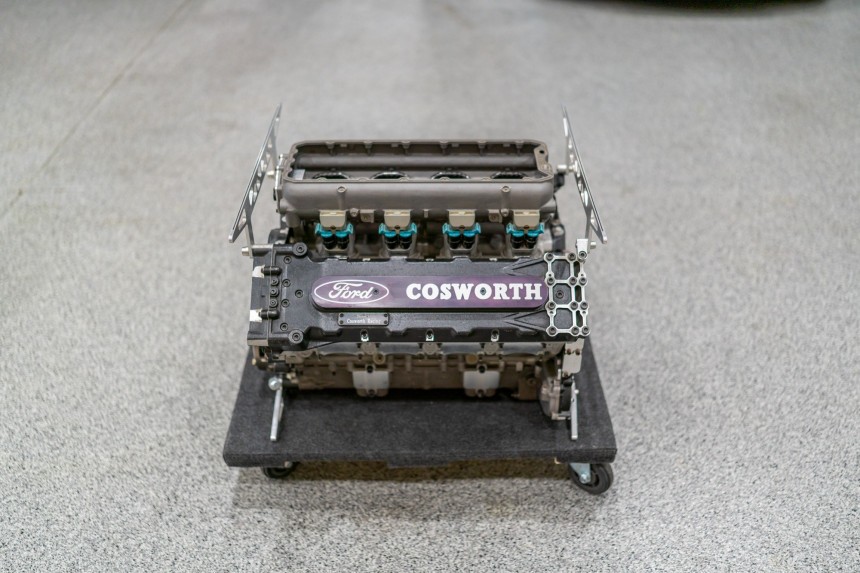Recently, we showcased to you a Ford-Cosworth XF V8 used in the now defunct CART open-wheel racing series for sale that's more likely to be turned into a table than to be put back in a race car. As it happens, the family of engines this particular unit hails from has a fascinating story all its own.
From an American perspective, one would expect an engine only 2,650 cc's (161.7-cubic inches) in size to be mounted inside a lowly economy car. But no. Inside the space that most engines its size can only squeeze four cylinders, Cosworth fit eight, and they did it for over 30 years. It's the Ford-Cosworth Indy V8 series, and it might just be the missing link between the Euro-centric Formula One and American offerings like IndyCar and CART/Champ racing.
Indeed, the often cozy relationship between Ford and the comparatively small engine maker based in the English East Midlands began as a means of improving on existing American racing engine technology with liberal doses of European engineering. From 1963 to 1971, Ford produced their own naturally aspirated pushrod V8 strictly for the USAC-sanctioned IndyCar series. Mounted inside a brilliant Lola T90 chassis with the even more brilliant A.J. Foyt behind the wheel, this engine won the 1967 Indy 500.
But by the turn of the 1970s, the state of the American racing scene was changing about as quickly as the domestic market of its passenger cars. In the previous decade, Ford had made forrays into racing series abroad on a scale not seen by any other U.S. automaker, as well as typical domestic American racing fare. Be it NASCAR, IndyCar, the 24 Hours of LeMans, and eventually Formula One, Ford's reach in racing was prolific and successful on a scale GM's and Chrysler's arguably weren't.
The result of this considerable R&D was a V8 engine that, in many ways, bridged the gap between American and European open-wheel racing. Enter the Double Four Valve, better known as the Cosworth DFV, a Formula one engine developed by the hot-shot team of Keith Duckworth and Mike Costin in 1967. With up to 530 horsepower on tap in later variants, this engine turned Formula One into the undisputed sport of kings in the racing world.
Everyone from Mario Andretti to James Hunt and Jackie Stewart revved the snot out of them to great success, earning Driver's Championships in the process. From the proverbial rib of the Cosworth DFV, a new methanol-fueled engine was created for competition on the other side of the world. Sporting a freshly added turbocharger and bucking the trend of "no replacement for displacement" by being de-stroked by almost half a liter to the F1 engine.
The Indy V8 was beloved by Indy 500 racers, USAC Champ Car drivers, and CART/Champ car competitors. The new engine was dubbed the DFX to differentiate it from the DFV. The two would go on to score hundreds of wins and dozens of driver championships between them. The DFV of Formula One fame was retired from production in 1983, but the DFX would continue to be honed and improved well into the 21st century.
This led to the shorter-stroke DFS engine in 1989, the last in the first generation Ford-Cossie Indy V8. During the 90s, the Ford-Cosworth Indy engine continued through the methanol-fueled X-series beginning in 1992. By the time the XF engine was seen for sale on Bring a Trailer recently, the engine was jetting as much as 850 horsepower in CART competition. Using non-race-sanctioned tunes with added boost, some race tuners were able to get that number past the 1000 barrier.
According to the former technical director of Formula One team British American Racing, Malcolm Oastler, there was never a time in history before or since when an American open-top racing series paralleled Formula One to such a significant degree than in the glory days of the X-Series Cosworth V8. Thanks in part to the engine itself, but also to profound changes in engineering on the part of CART.
"When Indy cars adopted smaller underbody 'tunnels' a couple of years ago, and Formula One cars moved to 'stepped' flat undersides, the two cars became fundamentally much closer in concept than they had been previously," Oastler told the Atlas Formula One Journal back in 1999, only months before the XF engine went into full-time service. With this in mind, it's a little bit sad that an engine with so much potential was applied to a racing series that wouldn't even see the end of the decade, let alone compete with F1 at the sales and advertisement level.
Check back soon for more from V8 Month and so much more right here on autoevolution.
Indeed, the often cozy relationship between Ford and the comparatively small engine maker based in the English East Midlands began as a means of improving on existing American racing engine technology with liberal doses of European engineering. From 1963 to 1971, Ford produced their own naturally aspirated pushrod V8 strictly for the USAC-sanctioned IndyCar series. Mounted inside a brilliant Lola T90 chassis with the even more brilliant A.J. Foyt behind the wheel, this engine won the 1967 Indy 500.
But by the turn of the 1970s, the state of the American racing scene was changing about as quickly as the domestic market of its passenger cars. In the previous decade, Ford had made forrays into racing series abroad on a scale not seen by any other U.S. automaker, as well as typical domestic American racing fare. Be it NASCAR, IndyCar, the 24 Hours of LeMans, and eventually Formula One, Ford's reach in racing was prolific and successful on a scale GM's and Chrysler's arguably weren't.
The result of this considerable R&D was a V8 engine that, in many ways, bridged the gap between American and European open-wheel racing. Enter the Double Four Valve, better known as the Cosworth DFV, a Formula one engine developed by the hot-shot team of Keith Duckworth and Mike Costin in 1967. With up to 530 horsepower on tap in later variants, this engine turned Formula One into the undisputed sport of kings in the racing world.
The Indy V8 was beloved by Indy 500 racers, USAC Champ Car drivers, and CART/Champ car competitors. The new engine was dubbed the DFX to differentiate it from the DFV. The two would go on to score hundreds of wins and dozens of driver championships between them. The DFV of Formula One fame was retired from production in 1983, but the DFX would continue to be honed and improved well into the 21st century.
This led to the shorter-stroke DFS engine in 1989, the last in the first generation Ford-Cossie Indy V8. During the 90s, the Ford-Cosworth Indy engine continued through the methanol-fueled X-series beginning in 1992. By the time the XF engine was seen for sale on Bring a Trailer recently, the engine was jetting as much as 850 horsepower in CART competition. Using non-race-sanctioned tunes with added boost, some race tuners were able to get that number past the 1000 barrier.
According to the former technical director of Formula One team British American Racing, Malcolm Oastler, there was never a time in history before or since when an American open-top racing series paralleled Formula One to such a significant degree than in the glory days of the X-Series Cosworth V8. Thanks in part to the engine itself, but also to profound changes in engineering on the part of CART.
Check back soon for more from V8 Month and so much more right here on autoevolution.


















